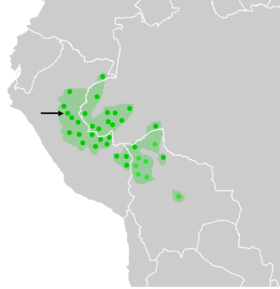Shipibo language
Not to be confused with Juruá Kapanawa language.
| Shipibo-Conibo | |
|---|---|
| Native to | Peru |
| Region | Ucayali Region |
| Ethnicity | Shipibo-Conibo people |
Native speakers | 26,000 (2003)[1] |
|
Panoan
| |
| Language codes | |
| ISO 639-3 |
Either: shp – Shipibo-Conibo kaq – Tapiche Capanahua |
| Glottolog |
ship1253[2] |
 | |
Shipibo (also Shipibo-Conibo, Shipibo-Konibo) is a Panoan language spoken in Peru and Brazil by approximately 26,000 speakers. Shipibo is an official language of Peru.
Dialects
a.jpg)
A Shipibo jar
Shipibo has three attested dialects:
- Shipibo and Konibo (Conibo), which have merged together
- Kapanawa of the Tapiche River, which is obsolescent
Extinct Xipináwa (Shipinawa) is thought to have been a dialect as well, but there is no linguistic data (Fleck 2013).
Phonology
Vowels

| Front | Central | Back | |
|---|---|---|---|
| Close | i ĩ | ɯ ɯ̃ | |
| Mid | o õ | ||
| Open | a ã |
- /i/ is near-close front unrounded [i̞].[3]
- /ɯ/ is close near-back unrounded [ɯ̟].[3]
- /ɯ/ is mid near-back unrounded [o̽].[3]
- /i, ɯ, o/ tend to be more central in closed syllables.[4]
- /a/ is near-open central unrounded [ɐ].[3]
- In connected speech, two adjacent vowels may be realized as a rising diphthong.[4]
Nasal
- The oral vowels /i, ɯ, o, a/ are phonetically nasalized [ĩ, ɯ̃, õ, ã] after a nasal consonant, but the phonological behaviour of these allophones is different from the nasal vowel phonemes /ĩ, ɯ̃, õ, ã/.[3]
- Oral vowels in syllables preceding syllables with nasal vowels are realized as nasal, but not when a consonant other than /w, j/ intervenes.[4]
Unstressed
- The second one of the two adjacent unstressed vowels is often deleted.[4]
- Unstressed vowels may be devoiced or even elided between two voiceless obstruents.[4]
Consonants
| Labial | Dental/ Alveolar |
Retroflex | Palatal | Velar | Glottal | ||
|---|---|---|---|---|---|---|---|
| Nasal | m | n | |||||
| Plosive | voiceless | p | t | k | |||
| Affricate | voiceless | ts | tʃ | ||||
| Fricative | voiceless | s | ʂ | ʃ | h | ||
| voiced | β | ||||||
| Approximant | w | ɻ | j | ||||
- /m, p, β/ are bilabial, whereas /w/ is labialized velar.
- /β/ is most typically a fricative [β], but other realizations (such as an approximant [β̞], a stop [b] and an affricate [bβ]) also appear. The stop realization is most likely to appear in word-initial stressed syllables, whereas the approximant realization appears most often as onsets to non-initial unstressed syllables.[3]
- /n, ts, s/ are alveolar [n, ts, s], whereas /t/ is dental [t̪].[5]
- The /ʂ–ʃ/ distinction can be described as an apical–laminal one.[3]
- /tʃ, ʃ/ are palato-alveolar, whereas /j/ is palatal.[5]
- Before nasal vowels, /w, j/ are nasalized [w̃, j̃] and may be even realized close to nasal stops [ŋʷ, ɲ].[4]
- /w/ is realized as [w] before /a, ã/, as [ɥ] before /i, ĩ/ and as [ɰ] before /ɯ, ɯ̃/. It does not occur before /o, õ/.[4]
- /ɻ/ is a very variable sound:
- Intervocalically, it is realized either as an approximant [ɻ], or sometimes as a (weak) fricative [ʐ].[3]
- Sometimes (especially in the beginning of a stressed syllable) it can be realized as a postalveolar affricate [d̠͡z̠], or a stop-appproximant sequence [d̠ɹ̠].[4]
- It can also be realized as a postalveolar flap [ɾ̠].[3]
References
- ↑ Shipibo-Conibo at Ethnologue (18th ed., 2015)
Tapiche Capanahua at Ethnologue (18th ed., 2015) - ↑ Hammarström, Harald; Forkel, Robert; Haspelmath, Martin; Bank, Sebastian, eds. (2016). "Shipibo-Konibo–Kapanawa". Glottolog 2.7. Jena: Max Planck Institute for the Science of Human History.
- 1 2 3 4 5 6 7 8 9 10 Valenzuela, Márquez Pinedo & Maddieson (2001), p. 282.
- 1 2 3 4 5 6 7 8 9 Valenzuela, Márquez Pinedo & Maddieson (2001), p. 283.
- 1 2 3 Valenzuela, Márquez Pinedo & Maddieson (2001), p. 281.
External links
| Wikimedia Commons has media related to Shipibo-Conibo. |
- Shipibo-Conibo at Ethnologue
- Lengua Shipibo at Proel
Bibliography
- Campbell, Lyle. (1997). American Indian languages: The historical linguistics of Native America. New York: Oxford University Press. ISBN 0-19-509427-1.
- Elias-Ulloa, Jose (2000). El Acento en Shipibo (Stress in Shipibo). Thesis. Universidad Nacional Mayor de San Marcos, Lima - Peru.
- Elias-Ulloa, Jose (2005). Theoretical Aspects of Panoan Metrical Phonology: Disyllabic Footing and Contextual Syllable Weight. Ph. D. Dissertation. Rutgers University. ROA 804 .
- Kaufman, Terrence. (1990). Language history in South America: What we know and how to know more. In D. L. Payne (Ed.), Amazonian linguistics: Studies in lowland South American languages (pp. 13–67). Austin: University of Texas Press. ISBN 0-292-70414-3.
- Kaufman, Terrence. (1994). The native languages of South America. In C. Mosley & R. E. Asher (Eds.), Atlas of the world's languages (pp. 46–76). London: Routledge.
- Loriot, James and Barbara E. Hollenbach. 1970. "Shipibo paragraph structure." Foundations of Language 6: 43-66. (This was the seminal Discourse Analysis paper taught at SIL in 1956-7.)
- Loriot, James, Erwin Lauriault, and Dwight Day, compilers. 1993. Diccionario shipibo - castellano. Serie Lingüística Peruana, 31. Lima: Ministerio de Educación and Instituto Lingüístico de Verano. 554 p. (Spanish zip-file available online http://www.sil.org/americas/peru/show_work.asp?id=928474530143&Lang=eng) This has a complete grammar published in English by SIL only available through SIL.
- Valenzuela, Pilar M.; Márquez Pinedo, Luis; Maddieson, Ian (2001), "Shipibo", Journal of the International Phonetic Association, 31 (2): 281–285, doi:10.1017/S0025100301002109
This article is issued from Wikipedia - version of the 6/30/2016. The text is available under the Creative Commons Attribution/Share Alike but additional terms may apply for the media files.